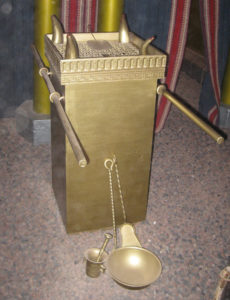Today we begin Exodus Chapter 30.
For the Complete Jewish Bible, click here.
For the King James Bible, click here.
“You are to make an altar on which to burn incense; make it of acacia-wood. It is to be eighteen inches square and three feet high; its horns are to be of one piece with it. Overlay it with pure gold — its top, all around its sides, and its horns; and put around it a molding of gold.”-Exodus 30:1-3
Recall that there were a total of three items in the Holy Place: the Menorah, the Table of Showbread, and the Altar of Incense.
We’ve already discussed the Menorah and the Table of Showbread.
So today I’d like to take a look at the 2nd most holy item in the Holy Place: the Altar of Incense (also called the Golden Altar).
Like the other items in the Tabernacle, it was constructed out of acacia wood and since it was to be placed in the Holy Place (the 2nd zone of holiness), it was overlaid with gold.
It’s dimensions were about 18 (width) x 18 (length) x 3 feet (height).
It was similar to the Brazen Altar in the Outer Courtyard in that it also had four horns on each corner.
And there was a rim built around the top with rings of gold put under it so that wooden poles could be inserted for easy and quick transport.
It was placed right in front of the PAROKHET (the curtain separating the Holy Place from the Holy of Holies) on the west side of the Holy Place, just as the Ark of the Covenant was placed on the west side of the Holy of Holies.
This location indicated how important it was.
Once a year, sacrificial blood was dabbed on the horns of the Golden Altar to purify it.
In addition, a specially prepared incense was to be continuously burnt on this Altar.
The smoke of this incense curling upwards towards the heavens represented the prayers of the people.
Since this Altar was located in the Holy Place, it was tended by the common priests most of the time.
However, it seems like it was the High Priest’s duty to keep the flames of the coals stoked.
Incense was to be added once in the morning and once in the evening at the time when the Menorah’s lamp wicks were being trimmed and oil added.
Now the truth be told, burning incense was a common worship practice in Middle Eastern cultures of that day.
Actually, animal sacrifices, incense burning and chanting prayers were already common things to most of the known world’s religious practices at this time.
So did the Israelites just borrow these “cultural” activities from the surrounding nations and adopt them as their own?
The answer is to a degree YES.
But there is one major caveat to this answer.
It was at God’s decree that they did so.
The takeaway here is this.
God has to deal with us on our level and in ways that our limited minds can understand.
Otherwise, we would never be able to comprehend His ways.
The point is that in order to get through to us, God will sometimes use methods that are familiar and normal to us, just like He did with ancient Israel so long ago.
However, there is one major difference between the pagan religious ceremonies of the day and what the Lord was ordaining for Israel.
Pagan rituals revolved around appeasing or satisfying the needs of a particular deity.
On the other hand, the Hebrew rituals were established for the benefit of man.
There is nothing we can do to appease or benefit God.
He has no such needs and doesn’t require appeasements.
The worship practices and ceremonies that the Lord ordained here in Exodus are a reflection of His love and mercy for His people.
They are also about establishing a justice system whereby man can be made holy and fellowship between God and man can become a reality.




Leave a Reply